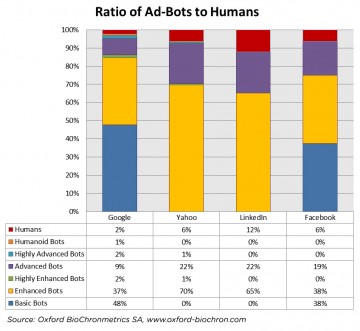Over 88% of Digital Ad Clicks Deemed Fraudulent, New Study by Oxford BioChronometrics Suggests
New study suggests that over 88% of digital ads are clicked by automated programs, not humans, costing advertisers billions of dollars. Bots evolving to circumvent current detection technology.

Luxembourg, February 3, 2015 (Newswire.com) - Oxford BioChronometrics, the Luxembourg-based company specializing in Human Recognition Technology, has conducted a study on fraud in digital advertising engagement that suggests between 88% and 98% of digital ad engagement is fraudulent. The results differ greatly from recently published studies claiming much lower percentages.
The study, conducted by Oxford BioChronometrics Chairman & Chief Technology Officer Adrian Neal and his team, involved placing digital ads on the Google, Yahoo, Facebook and LinkedIn advertising platforms. The ads were then monitored for engagement by automated programs known as bots as well as interaction by human beings.
Bots that commit ad fraud are getting ahead of the standard methods of detecting them. The common tools and methods of detection are no longer enough.
Adrian Neal, Chairman
The best performance the study saw was on the LinkedIn ad network, which had 88% fraudulent activity by bots. Google’s ad network was the worst with 98% bot fraud, while Yahoo and Facebook were tied for second at 94%. The study goes on to note that the team’s ads were billed for these fraudulent clicks and impressions.
“We didn’t make this press release lightly and we’re keenly aware of the ire it will draw,” explained Neal. “However, we believe that the integrity of the online community must be served and felt we had no choice but to go public with our findings. Advertisers make many online communities possible and it’s critically important to ensure the integrity of their online experience if we expect them to remain engaged. Only transparency can accomplish this and the time has come to shine a light on an area few are motivated to look at.”
“BioChronometrics represents an entirely new way of analyzing user/device interaction and, until now, the technology simply wasn’t available. Given the increased sophistication of automated programs and the subsequent increase in online click fraud, it’s not surprising that previous means of detection were unable to catch this level of fraud” added Sander Kouwenhoven, the company’s Managing Director of Information and Technology
Adding to the challenges faced by advertisers and internet advertising agencies, Neal and his team also emphasized the fact that bots are getting better. “We classified 6 different categories of bots, from Basic to Highly Advanced, including one that we can only classify as Humanoid.”
Humanoid bots can only be detected through deep behavioral analysis with particular emphasis on attempts to subsequently introduce measures of random behavior that mimic natural human behavior. “What this means,” Neal explained, “is that people who deploy the bots that commit ad fraud are getting ahead of the standard methods of detecting them. The common tools and methods of detection are no longer enough.”
This study is in-part driven by Google’s recommendation in their Nov. 2014 report “The Importance of Being Seen” that advertisers should aim for above 50% viewability rather than simple impressions rendered as a metric. “The threshold of 50% strikes us as too low,” stated David Scheckel, the company’s CEO. “Especially because we know our Digital Ad Protection Technology can achieve near 100% viewability and guarantee actual human clicks.”
The study is available for download at the Oxford BioChronometrics website here: http://oxford-biochron.com/research/
About Oxford BioChronometrics
Luxembourg-based Oxford BioChronometrics was founded in 2012 by Adrian Neal and a team of software engineering Masters' graduate and cryptographics experts with decades of experience in IT, Banking and Security. Spun out earlier this year from Oxford University’s Isis Software Incubator, the company offers its behaviour-based user authentication, bot blocking and Digital Advertisement Protection Technology (DAPT) to companies large and small around the globe. Known for creating e-DNA, electronically Defined Natural Attributes, Oxford BioChronometrics offers the most secure user authentication technology currently on the market. For more information, visit www.oxford-biochron.com.
